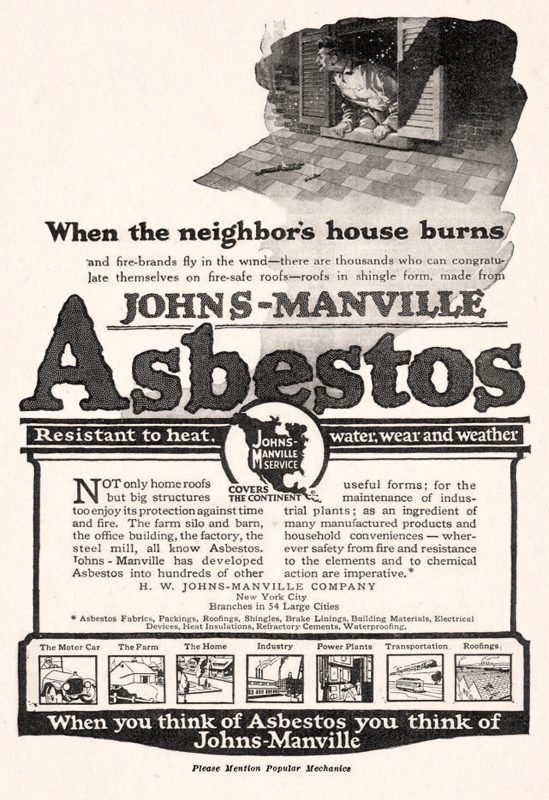 Asbestos and mesothelioma litigation has not always been the way we know it today. Early asbestos cases only involved workers in occupations like pipe insulation, construction, and shipyard work.
Asbestos and mesothelioma litigation has not always been the way we know it today. Early asbestos cases only involved workers in occupations like pipe insulation, construction, and shipyard work.
Gradually, these cases shifted to other occupations such as steam fitters and oil refinery workers, as additional negligent asbestos exposures were discovered.
During this time, however, mesothelioma and asbestos cancer cases only made up a small portion of early asbestos claims. The majority included non-malignant cases that involved scarring of the internal lung tissue (asbestosis) and scarring of the lining of the chest cavity (pleural scarring).
This beginning phase of asbestos litigation is just one part of a timeline of events that spans the past century.
Certain moments in asbestos litigation history have influenced the mesothelioma lawsuit landscape by causing it to evolve into what we know today.
Important Dates in Asbestos Litigation History
1898 – The annual reports of the Chief Inspector of Factories in Britain mentions “easily demonstrated” health risks from asbestos.
1899 – A factory worker dies from an industrial disease. London doctor H. Montague Murray conducts a post mortem exam and finds asbestos in the man’s lung tissue.
1908 – The United States enacts the Federal Employers’ Liability Act (FELA) into federal law. The FELA was established to protect and compensate railroad workers injured by various circumstances (including asbestos exposure) while on the job.
1924 – Nellie Kershaw, a 33-year-old female asbestos worker, dies from asbestosis and becomes the first case to be described in medical literature.
1927 – The first known U.S. workers’ compensation claim for asbestos disease is created.
1930 – The first asbestosis sufferer autopsy is conducted in the United States and later presented by a doctor at the Mayo Clinic.
1930 – Also in this year, asbestos company Johns-Manville produces an internal report about medical reports of asbestos worker fatalities.
1933 – Johns-Manville officials settle 11 lawsuits by employees suffering from asbestosis on a condition that they agree to never “directly or indirectly participate in the bringing of new actions against the Corporation.”
1935 – Officials of Johns-Manville and Raybestos-Manhattan order the editor of Asbestos magazine to publish nothing about asbestosis.
1936 – A group of companies agree to sponsor medical research on the health effects of asbestos dust, on the condition that the companies maintain control over the disclosure of those results.
1943 – The U.S. Navy uses asbestos for the production of ships for World War II. A majority of current mesothelioma cases come from U.S. Navy veterans.
1951 – Asbestos companies remove all references to cancer before research they sponsor can be published.
1970 – The Clean Air Act is passed, allowing the United States Environmental Protection Agency (EPA) to regulate asbestos.
1973 – The first major asbestos lawsuit is won. An insulation worker wins a settlement from large asbestos manufacturers.
1977 – Hidden documents containing details on the efforts of large companies to cover up the health hazards of asbestos (Sumner Simpson Papers) are used against defendant manufacturers in court.
1981 – The EPA requests information from all American companies on any asbestos content in their products.
1982 – Johns-Manville, the largest American manufacturer of asbestos products, files for bankruptcy after a major increase in asbestos lawsuits against them.
1989 – The EPA issues the Asbestos Ban and Phase Out Rule, which bans many asbestos products.
1991 – The aforementioned ban is overturned, allowing some asbestos products to continue to be produced and used in the United States. Products that remain banned are asbestos flooring, rollboard, and asbestos paper.
1994 – Mesothelioma is officially recognized by the World Health Organization as an asbestos-related disease.
2003 – The largest asbestos verdict for a single plaintiff is awarded for $250 million. The Firm plays a role in this influential win.
2006 – The Owens Corning Fibreboard Asbestos Personal Injury Trust is established.
2006 – The Armstrong World Industries Asbestos Personal Injury Settlement Trust is established.
2007 – The U.S. Senate passes the “Ban Asbestos in America Act”, which bans asbestos-containing products except materials containing less than one percent asbestos. The bill does not go to the House or become law.
2008 – H.R. 6903, also known as the “Bruce Vento Ban Asbestos and Prevent Mesothelioma Act of 2008” is introduced in the U.S. House of Representatives. The bill was designed to amend the Toxic Substances Control act by reducing health risks associated with asbestos-containing products. Bruce Vento was a politician who died from mesothelioma in 2000. The bill did not go to House or Senate votes.
2009 – The ASARCO LLC Asbestos Personal Injury Settlement Trust is established.
2009 – Senate Resolution 57 designates the first week of April as National Asbestos Awareness Week.
2010– The state of Washington issues a ban for asbestos in automotive brakes, which goes into effect in 2014.
2013 – The Furthering Asbestos Claim Transparency (FACT) Act is introduced in the U.S. House of Representatives. The bill will delay and/or deny justice and compensation for individuals suffering from asbestos-related diseases.
Asbestos litigation has evolved over the years, and it will continue to change in the future. Although much progress has been made within the mesothelioma litigation landscape, there is still advancement to be sought. With the introduction of bills like the FACT Act, justice for victims of mesothelioma or other asbestos-related diseases will continue to be threatened. To make your voice heard and help stop the FACT Act from passing, learn what you can do now.
To get help take legal action over a mesothelioma or asbestos-related disease diagnoses, call (800) 326-8900 or get a free case review now.




